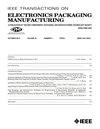Tin Whisker Test Development—Temperature and Humidity Effects Part II: Acceleration Model Development
IEEE Transactions on Electronics Packaging Manufacturing
Pub Date : 2010-01-01
DOI:10.1109/TEPM.2009.2032919
引用次数: 16
Abstract
The incubation time for both whisker growth and corrosion in thin Sn platings (3-10 ¿m thick) on Cu-based alloys have been found to be well represented by an exponential function of humidity and an Arrhenius function of temperature for both as-deposited and reflowed tin platings. Furthermore, whisker growth was found to follow the same functionality in both corroded and non-corroded regions of the plating. The effective activation energies and humidity coefficients were found to depend upon plating thickness, exposure to reflow, and presence of corrosion. The effective activation energies ranged from 0.23 eV to 0.41 eV and the humidity coefficients ranged from -0.012% to -0.031%. Corrosion enhanced whisker growth occurred by lowering the effective activation energy for whisker growth. A theory based on excess, non-creep relaxed, oxidation induced strain was developed to explain the corrosion induced energy barrier lowering. The data showed that 60°C/87%RH appears to be the optimal high temperature/high humidity test condition at this time for Sn over Cu substrates. Within the limits of the whisker and corrosion (incubation) acceleration functions developed in this study, it is concluded that the JEDEC tests can be used to indicate behavior at other temperature/humidity points that could be relevant storage or service conditions.锡晶须试验发展-温度和湿度影响第二部分:加速模型发展
在铜基合金上镀锡(3-10 μ m厚)时,晶须生长和腐蚀的培养时间均表现为湿度的指数函数和沉积和回流锡的温度的Arrhenius函数。此外,在腐蚀和未腐蚀的镀层区域,晶须生长遵循相同的功能。发现有效活化能和湿度系数取决于镀层厚度、回流暴露和腐蚀的存在。有效活化能范围为0.23 ~ 0.41 eV,湿度系数范围为-0.012% ~ -0.031%。腐蚀通过降低晶须生长的有效活化能来促进晶须的生长。提出了一种基于过量、非蠕变松弛、氧化诱发应变的理论来解释腐蚀引起的能垒降低。数据表明,60°C/87%RH是此时Sn over Cu衬底的最佳高温/高湿测试条件。在本研究中开发的晶须和腐蚀(孵育)加速函数的限制范围内,得出的结论是,JEDEC测试可用于指示其他温度/湿度点的行为,这些温度/湿度点可能与存储或使用条件相关。
本文章由计算机程序翻译,如有差异,请以英文原文为准。
求助全文
约1分钟内获得全文
求助全文

 求助内容:
求助内容: 应助结果提醒方式:
应助结果提醒方式:


